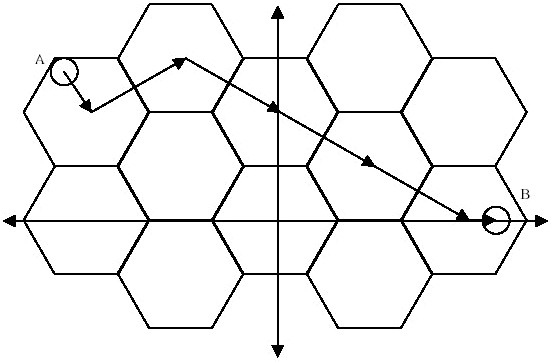UVa1531 - Problem Bee
来源:互联网 发布:用循环给二维数组赋值 编辑:程序博客网 时间:2024/05/17 06:54
Imagine a perfectly formed honeycomb, spanning the infinite Cartesian plane. It is an interlocking grid composed of congruent equilateral hexagons. One hexagon is located so that its center is at the origin and has two corners on the X-axis. A bee must be very careful about how it travels in order not to get lost in the infinite plane. To get from an arbitrary point A to another arbitrary point B, it will first head from A to the exact center of the hexagon in which A is located. Then, it will travel in a straight line to the exact center of an adjacent hexagon. It will move from center to adjacent center until it has reached the hexagon containing point B. At the destination hexagon, it will move from the center to point B. In all cases, the bee will take a path of minimal distance that obeys the rules. The figure below demonstrates one possible minimal path from point A to point B.

Input
Input will be in the form of 5 floating point numbers per line. The first number will be the length, in centimeters, of the sides of the hexagons. The next two numbers will be the x and y coordinates of point A, followed by the x and y coordinates of point B. The input will be terminated by a line containing five zeroes. Neither point A nor point B will ever be exactly on a border between hexagons.
Output
For each line of the input, output the minimum length of a path from point A to point B, to the nearest 0.001 centimeters.
Sample Input
1.0 -3.2 2.2 3.3 09 1 4 5 10.1 0.09 0 0.21 00 0 0 0 0
Sample Output
7.7375.0000.526
#include <cstdio>#include <cmath>#include <algorithm>using namespace std;const double EPS = 1e-6;const double SQRT3 = sqrt((double)3);const int dir[7][2] = {{0, 0}, {-1, 1}, {0, 2}, {1, 1}, {1, -1}, {0, -2}, {-1, -1}};struct Point{ double x, y;};double r, xa, ya, xb, yb;double stepx, stepy;bool input();Point findFirstSection(double x, double y);Point find(double x, double y);void solve();int main(){#ifndef ONLINE_JUDGE freopen("d:\\OJ\\uva_in.txt", "r", stdin);#endif while (input()) { solve(); } return 0;}bool input(){ if (scanf("%lf%lf%lf%lf%lf", &r, &xa, &ya, &xb, &yb) != 5 || !(r || xa || ya || xb || yb)) return false; stepx = 1.5 * r; stepy = SQRT3 / 2 * r; return true;}Point findFirstSection(double x, double y){ int dx = (int)(x / stepx); int dy = (int)(y / stepy); if (dx & 1) { if (!(dy & 1)) dy++; } else { if (dy & 1) dx++; } double Min = 0x3f3f3f3f; Point ans; for (int i = 0; i < 7; i++) { double tmpx = stepx * (dx + dir[i][0]); double tmpy = stepy * (dy + dir[i][1]); double tmp = sqrt(pow(tmpx - x, 2) + pow(tmpy - y, 2)); if (tmp < Min) { ans.x = tmpx; ans.y = tmpy; Min = tmp; } } return ans;}Point find(double x, double y){ Point ans; if (x > 0 && y > 0) { ans = findFirstSection(x, y); } else if (x < 0 && y > 0) { ans = findFirstSection(-x, y); ans.x = -ans.x; } else if (x < 0 && y < 0) { ans = findFirstSection(-x, -y); ans.x = -ans.x; ans.y = -ans.y; } else { ans = findFirstSection(x, -y); ans.y = -ans.y; } return ans;}void solve(){ Point a = find(xa, ya); Point b = find(xb, yb); double dis; if (fabs(a.x - b.x) < EPS && fabs(a.y - b.y) < EPS) { dis = sqrt(pow(xa - xb, 2) + pow(ya - yb, 2)); printf("%.3lf\n", dis); return; } int x1 = (int)(fabs(a.x - b.x) / stepx + 0.5); int x2 = (int)(fabs(a.y - b.y) / stepy + 0.5); int d; if (x1 >= x2) { d = x1; } else { d = x1 + (x2 - x1) / 2; } dis = sqrt(pow(a.x - xa, 2) + pow(a.y - ya, 2)) + sqrt(pow(b.x - xb, 2) + pow(b.y - yb, 2)) + d * SQRT3 * r; printf("%.3lf\n", dis);}- UVa1531 - Problem Bee
- POJ1518、 UVA1531 - Problem Bee(几何+贪心)
- poj 1518 Problem Bee
- UVa 1531 - Problem Bee
- POJ 1518 Problem Bee 笔记
- POJ 1518 Problem Bee 笔记
- bee
- bee
- Bee
- UVa Problem 10182 Bee Maja (蜜蜂 Maja)
- uva 1531 & poj 1518 Problem Bee(几何计算+贪心)
- Practice Round APAC test 2017--Problem A. Lazy Spelling Bee
- Practice Round APAC test 2017——1.Problem A. Lazy Spelling Bee
- Problem A. Lazy Spelling Bee Google APAC 2017 University Test Practice Round
- bee(github.com/beego/bee)源码分析
- bee(github.com/beego/bee)源码分析
- $ bee bash: bee: command not found
- 忙 as a bee...
- ios 根据手势放大或缩小图片
- Visual Studio 2013、TortoiseSVN、TortoiseGit、msysgit编译Tesseract(tesseract-ocr)
- await-async
- Log4Net的使用
- Duilib中列表项添加数据
- UVa1531 - Problem Bee
- THINKPHP框架配置
- HDU 1401 Solitaire (双向广搜)
- OCP 1Z0 052 147
- cf442B Andrey and Problem
- 如果我很爱你你会答应我吗
- Eclipse 安装最新SVN插件
- 常见的php笔试题(附答案)搜集整理
- No.04 Xcode(5.x) app的测试与发布


